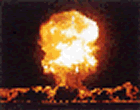Nuclear Weapons
RadTown USA Topics
RadTown USA Topics
This page gives a brief overview of how plutonium was used as the primary radioactive material in nuclear weapons.
On this page:
Overview
Following the end of the Cold War, the United States ended production and testing of nuclear weapons. During the 1990’s the nuclear weapons program changed its focus from making new nuclear weapons to keeping existing warheads for the indefinite future.
 Plutonium is the primary radioactive material in nuclear weapons; when bombs are detonated, the plutonium undergoes fission and releases enormous amounts of energy.
Plutonium is the primary radioactive material in nuclear weapons; when bombs are detonated, the plutonium undergoes fission and releases enormous amounts of energy.
Between 1944 and 1988, the United States built and operated nuclear reactors at high-security government facilities, producing about 100 metric tons of plutonium for the creation of nuclear weapons. The reactors made plutonium by bombarding special fuel rods, containing uranium, with neutrons. Once the maximum amount of plutonium was produced, workers removed the highly-radioactive spent fuel rods from the reactors.
Workers used strong acid and chemicals to separate the plutonium from the fuel rod. This very process left behind more than 100 million gallons of hazardous mixed wastes of acids and radioactive fission products. Part of the legacy of nuclear weapons production is the safe management, storage and disposal of these wastes.
Who is protecting you
U.S. Environmental Protection Agency (EPA)
EPA regulates the releases of radioactive material that travel beyond the federal facility boundaries. Section 112 of the Agency’s National Emission Standards for Hazardous Air Pollutants (NESHAPs) helps federal facilities manage airborne releases of radiation.
U.S. Department of Energy (DOE)
DOE’s Stockpile Stewardship Program (SSP) assesses the safety, security and reliability of existing nuclear warheads without the use of nuclear testing.
The Environment, Safety and Health (ESH) office develops and manages programs that protect DOE radiation workers and the communities surrounding DOE facilities.
U.S. Department of Defense (DoD)
The Army, Navy, Air Force, Coast Guard and Marines are required to implement DoD and EPA regulations that prevent releases of radioactive materials from DoD facilities.
What you can do to protect yourself
Since plutonium levels in the environment are very low, they pose little risk to most people. However, people who live near government weapons production facilities or testing sites may have a higher risk of exposure. You can contact your local facility or your state radiation office to get more information on monitoring data and existing safety measures.
Resources
| EPA
Federal Facilities Regulations 30 June 2005. U.S. Environmental Protection Agency This site provides information and links to EPA’s compliance and enforcement program and applicable regulations for federal facilities. |
| NESHAPS for
Radiation June 2005. U.S. Environmental Protection Agency This site provides information about EPA’s Radiation NESHAPS including DOE facilities. |
| Radionuclides 30 November 2004. U.S. Environmental Protection Agency This site provides fact sheets on many of the most commonly encountered radionuclides. |
| Conference of Radiation Control Program Directors
8 January 2006. Conference of Radiation Control Program Directors This site provides general information about nuclear energy and links to federal agencies, international organizations, and other resources. |
| Defense Programs 15 February 2006. U.S. Department of Energy , National Nuclear Safety Administration This site provides information about NNSA’s program to maintain and enhance national security through military applications. |
| Environmental
Management System – Defense Environmental Network & Information
Exchange (DENIX) 24 June 2005.U.S. Department of Defense This site provides information on the Department's effort to clean up environmental contamination at active and closing military bases and former properties. |
| Environment, Safety and Health 24 June 2005. U.S. Department of Energy , Office of Environment, Safety, and Health This site provides information about DOE’s nuclear facility safety policies and programs. |
| Uranium
Stewardship Activities 5 January 2006. U.S. Department of Energy , Office of Nuclear Energy, Science, & Technology This page provides a history of nuclear energy. |
![[logo] US EPA](https://webarchive.library.unt.edu/eot2008/20090117043755im_/http://www.epa.gov/epafiles/images/logo_epaseal.gif)